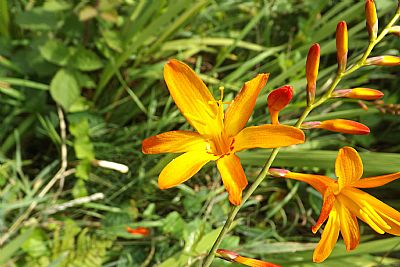MONTBRETIA / CROCOSMIA
In some areas this is considered an invasive species.
This is a popular plant for gardens. It is not native though and what you are likely to see here are hybrids of those introduced from places such as South Africa. If left unchecked it can proliferate and oust other species.
Wiki tells us :
The genus name is derived from the Greek words krokos, meaning "saffron", and osme, meaning "odor" – from the dried leaves emitting a strong smell like that of saffron (a spice derived from Crocus – another genus belonging to the Iridaceae) – when immersed in hot water.
The alternative name montbretia is still widely used, especially for the garden hybrid C. × crocosmiiflora. "Montbretia" commonly used in the British Isles for orange-flowered C. × crocosmiiflora cultivars that have naturalised, while "crocosmia" is reserved for less aggressive red-flowered cultivars.
The beautiful red or slightly orrange flowers have become a common sight around West Dunbartonshire. Their tall stems amidst equally tall reed-like leaves waft in the breeze. There are 400 varieties of montbretia and we cannot be more specific about which ones are found growing feral here. We often see both orange and red varieties.
The Environet website says :
Montbretia crocosmia x crocosmiiflora was first bred in the 1880s and came to the UK via France, although its origin is distinctly South African. It has been a popular plant in gardens for most of that time and is more common in western parts of England, Wales and Scotland.
It’s different from many other plants in that it has corms which are fleshy underground parts of the stem. These corms act as a storage organ for the plant, but they can also initiate growth in much the same way as a bulb. The corms of the Montbretia plant can grow quite deep which makes fully eradicating it problematic.
While it is an attractive plant, it is now listed in Schedule 9 of the Wildlife and Countryside Act 1981 as invasive although it is not illegal to have Montbretia on your property, Whether you do or not, you must pay special attention to how you dispose of cuttings and corms if you want to get rid of them.
The examples below are growing alongside the Leven towpath upstream from Bonhill Bridge (2023). At this point they are not a problem and are in fact very attractive, but they need to be monitored in sensitive environments.

Elegant splashes of bright red amongst a number of other plants on the Leven towpath.....but we must not be complacent as they can soon become problematic.


A rich red plant on the Leven towpath.

And an oranage one.
ENVIRONET : https://www.environetuk.com/invasive-species/montbretia/identification
WIKIPEDIA : https://en.wikipedia.org/wiki/Crocosmia

